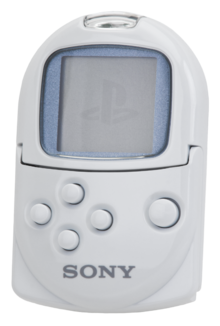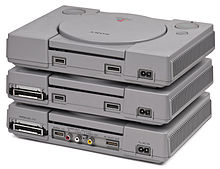PlayStation (console)
![]()
This article is about the game console. For the game console brand of the same name based on it, see PlayStation (brand).
![]()
This article or subsequent section is not sufficiently supported by evidence (e.g., anecdotal evidence). Information without sufficient evidence may be removed in the near future. Please help Wikipedia by researching the information and adding good supporting evidence.
The PlayStation (jap. プレイステーション, Pureisutēshon, official abbreviation: PS, codename: PSX, also known as PS1) is a stationary game console made by the Japanese company Sony, which was first sold in Japan on December 3, 1994 and whose production was finally discontinued after twelve years of sales, in 2006. The PlayStation is the first game console of the PlayStation brand. With Ken Kutaragi as chairman of the Sony Computer Entertainment subsidiary, the PlayStation became one of the most successful game consoles of all time (102.5 million units sold worldwide) and toppled the former market leader Nintendo from its throne in the home console segment.
Accessories
The PlayStation offers two ports for various controllers that are used to control the characters in a game. The original PlayStation joypad offers four main buttons (cross, circle, triangle, square) for the thumb of the right hand, which trigger actions in most games, two selection buttons (Select and Start) placed in the middle, and four shoulder buttons (L1, L2, and R1 and R2), which are operated with the index fingers and often perform secondary control tasks. Directions are indicated with the thumb of the left hand on a 4-way directional pad, with diagonals being achieved by pressing two directions simultaneously (for example, up and right = diagonal to right up). On April 25, 1997, an analog controller was also introduced, which took Nintendo's idea of analog sticks, but offered two of them at once. These small control sticks allowed for infinitely variable directional control with varying levels of impact, allowing for more sensitive control compared to a directional pad. The design of the PlayStation joypad remained largely unaffected, as the two analog sticks were merely added to the bottom of the joypad during development. However, the rear shoulder buttons (L2, R2) were enlarged quite a bit to increase comfort, and the joypad was given two more buttons. L3 and R3 are located under the analog sticks and are activated when you press one of the analog sticks down.
However, the DualShock controller, introduced on November 20, 1997 with the game Gran Turismo, quickly replaced the analog controller. It was the same in design, but offered an optional rumble function. This technology used semi-circular metal bricks built into the joypad to rotate. The resulting imbalance caused the joypad to vibrate during certain game scenes. The vibration of the joypad in the hands of the player was supposed to increase the impression of action-packed game scenes even more, which was very popular with both software manufacturers and gamers and was used in almost every game of the fading PlayStation 1 era. Before long, the DualShock controller was declared the standard PlayStation joypad, so new units shipped only with it. Some games created late in the system's life cycle even require an analog controller. The design and technology can also be found in PlayStation 2 and PlayStation 3 controllers, the DualShock 2, the Sixaxis as well as the DualShock 3; however, in these versions the former digital buttons are also continuously analog switched, Sixaxis and DualShock 3 are even wireless and motion sensitive.
Other peripherals for the Sony PlayStation include:
- The Multi Tap. With this, for example, the number of controllers can be expanded to five and the number of memory cards to four. With two Multi Taps, even up to eight players with eight memory cards can compete with each other. However, this is only supported by a few games (e.g. Football Live).
- Light Guns (e.g. Just! a Gun, Namco G-con 45)
- Dance mats
- PlayStation Mouse
- wireless joypads
- Arcade Joypads
- Dual analog joystick
- other so-called freakware, such as small pseudo electric guitars needed to play certain software titles.
- different cheat modules for the expansion slot in the back
- a module for the expansion slot in the back to play VCDs
- Controllers from other manufacturers in various colors and shapes, design often similar to the original
- Link cable
- coloured housings (also transparent) from other manufacturers
- Modchips, Ghostchips for playing import games or backup copies, respectively
- Cheatmodul replacement for the PSone in form of a CD
- Memory Cards from Sony in different colours with 120 Kilobytes size (15 blocks with 8 KB each)
- Memory cards from third-party manufacturers in sizes of several megabytes
- Adapter for playing Game Boy games for the expansion slot (from third-party manufacturers)
- DexDrive floppy disk drive for saving game files to standard 3.5" floppy disks (from other manufacturers)
- various liquid crystal displays attachable to the PSone, both Sony and non-Sony
- PSIO, a plug-in module for the PlayStation Parallel I/O port, which allows to run homebrews and backups from an SD

DualShock controller

First PlayStation Joypad

memory card

PocketStation
Hardware
Technical data
Technical data of the PlayStation. These apply to the PlayStation (PS) and the slightly smaller PlayStation One (PSone).
- CPU: 32-bit MIPS RISC (R3000A custom), clock frequency: 33.8688 MHz (30 MIPS performance)
- Working memory: 2 MB RAM
- ROM: 512 kB
- Graphics: PlayStation GPU, 1 MB graphics RAM
- Color depth: 4 bit to 24 bit (16.7 million colors)
- resolution: 320 × 240 to 640 × 480 (NTSC, interlaced) or 512 × 384 (PAL) pixels
- Texture Mapping and Flat or Gouraud Shading
- MDEC chip for hardware decoding of movies (for example Full Motion Video)
- Sound: SPU ADPCM, 24 channels, 512 kB sound RAM, MIDI support
- Drive: 2-fold CD-ROM drive, 32 kB buffer, 660 MB storage space
- European models
- The PlayStation model SCPH-1002 used the KSM-440ACM drive.
- The PlayStation models SCPH-5502, SCPH-5552 and SCPH-7002 used the KSM-440ADM drive.
- The PlayStation models SCPH-7502 and SCPH-9002 used the KSM-440AEM drive.
- The PSone, which has the model number SCPH-102, uses the KSM-440BAM drive.
Interfaces
- 2× controller connections
- 2× memory card slots
- AV Multi-Out (proprietary connector that outputs stereo sound, composite video, S-Video, and RGB signals)
- AV RCA outputs for stereo sound and composite video (SCPH-1002 only)
- S-Video Hosiden socket (only for models for the Japanese market)
- Serial I/O for multiplayer (not on the PSone)
- Parallel I/O for external modules (e.g. so called cheat modules e.g. "Xploder", has been omitted in the last version SCPH-9002)
Dimensions
(height × width × depth)
- PS:one 60 × 270 × 188 mm³
- PSone: 38 × 194 × 146 mm³ (approximately 35 % of the volume of the original PS)

Comparison of SCPH-1001 (bottom), SCPH-5501 (middle) and SCPH-9001 (top)
Search within the encyclopedia